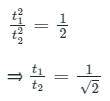ACT Exam > ACT Questions > Two balls are dropped from heights h and 2h r...
Start Learning for Free
Two balls are dropped from heights h and 2h respectively. What would be the ratio of times taken by the balls to reach the earth?
- a)√2 ∶ 1
- b)1 ∶ √2
- c)2 ∶ 1
- d)4 ∶ 119
Correct answer is option 'B'. Can you explain this answer?
Verified Answer
Two balls are dropped from heights h and 2h respectively. What would b...
Concept:
For a body moving in a straight line with constant acceleration, then
- v = u + at --- (1)
- s = ut + 0.5at2 --- (2)
- v2 = u2 + 2as --- (3)
- Where u = initial velocity, v = final velocity, a = acceleration, s = displacement, t = time
Calculation:
Given that, for first ball, height, h1 = h and let time = t1
And for the second ball, height, h2 = 2h and time = t2
Since the object is falling freely then acceleration = g
Initial velocity for both the bodies, u = 0
Then from equation 2, for first ball
h1 = ut + 0.5gt12
⇒ h = 0 + 0.5gt12 --- (4)
For second ball,
h2 = ut + 0.5gt22
⇒ 2h = 0 + 0.5gt22 --- (5)
Dividing equation 4 by 5


Most Upvoted Answer
Two balls are dropped from heights h and 2h respectively. What would b...
Ratio of times taken by the balls to reach the earth:
- Let's assume the height from which the balls are dropped is h for the first ball and 2h for the second ball.
- The time taken by an object to fall from a certain height can be calculated using the formula: time = √(2h/g), where g is the acceleration due to gravity (approximately 9.8 m/s²).
Time taken by the first ball (h):
- For the first ball dropped from height h, the time taken to reach the earth can be calculated as: t1 = √(2h/g).
Time taken by the second ball (2h):
- For the second ball dropped from height 2h, the time taken to reach the earth can be calculated as: t2 = √(2(2h)/g) = √(4h/g) = 2√(h/g).
Ratio of times taken by the two balls:
- To find the ratio of times taken by the two balls, we divide the time taken by the second ball by the time taken by the first ball: t2/t1 = 2√(h/g) / √(2h/g) = 2√(h/g) / √(2h/g) = 2√(h/g) * √(g/2h) = 2√(h/2h) = 2√(1/2) = √2.
Therefore, the ratio of times taken by the two balls to reach the earth is √2, which corresponds to option b) 1 √2.
- Let's assume the height from which the balls are dropped is h for the first ball and 2h for the second ball.
- The time taken by an object to fall from a certain height can be calculated using the formula: time = √(2h/g), where g is the acceleration due to gravity (approximately 9.8 m/s²).
Time taken by the first ball (h):
- For the first ball dropped from height h, the time taken to reach the earth can be calculated as: t1 = √(2h/g).
Time taken by the second ball (2h):
- For the second ball dropped from height 2h, the time taken to reach the earth can be calculated as: t2 = √(2(2h)/g) = √(4h/g) = 2√(h/g).
Ratio of times taken by the two balls:
- To find the ratio of times taken by the two balls, we divide the time taken by the second ball by the time taken by the first ball: t2/t1 = 2√(h/g) / √(2h/g) = 2√(h/g) / √(2h/g) = 2√(h/g) * √(g/2h) = 2√(h/2h) = 2√(1/2) = √2.
Therefore, the ratio of times taken by the two balls to reach the earth is √2, which corresponds to option b) 1 √2.

|
Explore Courses for ACT exam
|

|
Question Description
Two balls are dropped from heights h and 2h respectively. What would be the ratio of times taken by the balls to reach the earth?a)√2 1b)1 √2c)2 1d)4 119Correct answer is option 'B'. Can you explain this answer? for ACT 2025 is part of ACT preparation. The Question and answers have been prepared according to the ACT exam syllabus. Information about Two balls are dropped from heights h and 2h respectively. What would be the ratio of times taken by the balls to reach the earth?a)√2 1b)1 √2c)2 1d)4 119Correct answer is option 'B'. Can you explain this answer? covers all topics & solutions for ACT 2025 Exam. Find important definitions, questions, meanings, examples, exercises and tests below for Two balls are dropped from heights h and 2h respectively. What would be the ratio of times taken by the balls to reach the earth?a)√2 1b)1 √2c)2 1d)4 119Correct answer is option 'B'. Can you explain this answer?.
Two balls are dropped from heights h and 2h respectively. What would be the ratio of times taken by the balls to reach the earth?a)√2 1b)1 √2c)2 1d)4 119Correct answer is option 'B'. Can you explain this answer? for ACT 2025 is part of ACT preparation. The Question and answers have been prepared according to the ACT exam syllabus. Information about Two balls are dropped from heights h and 2h respectively. What would be the ratio of times taken by the balls to reach the earth?a)√2 1b)1 √2c)2 1d)4 119Correct answer is option 'B'. Can you explain this answer? covers all topics & solutions for ACT 2025 Exam. Find important definitions, questions, meanings, examples, exercises and tests below for Two balls are dropped from heights h and 2h respectively. What would be the ratio of times taken by the balls to reach the earth?a)√2 1b)1 √2c)2 1d)4 119Correct answer is option 'B'. Can you explain this answer?.
Solutions for Two balls are dropped from heights h and 2h respectively. What would be the ratio of times taken by the balls to reach the earth?a)√2 1b)1 √2c)2 1d)4 119Correct answer is option 'B'. Can you explain this answer? in English & in Hindi are available as part of our courses for ACT.
Download more important topics, notes, lectures and mock test series for ACT Exam by signing up for free.
Here you can find the meaning of Two balls are dropped from heights h and 2h respectively. What would be the ratio of times taken by the balls to reach the earth?a)√2 1b)1 √2c)2 1d)4 119Correct answer is option 'B'. Can you explain this answer? defined & explained in the simplest way possible. Besides giving the explanation of
Two balls are dropped from heights h and 2h respectively. What would be the ratio of times taken by the balls to reach the earth?a)√2 1b)1 √2c)2 1d)4 119Correct answer is option 'B'. Can you explain this answer?, a detailed solution for Two balls are dropped from heights h and 2h respectively. What would be the ratio of times taken by the balls to reach the earth?a)√2 1b)1 √2c)2 1d)4 119Correct answer is option 'B'. Can you explain this answer? has been provided alongside types of Two balls are dropped from heights h and 2h respectively. What would be the ratio of times taken by the balls to reach the earth?a)√2 1b)1 √2c)2 1d)4 119Correct answer is option 'B'. Can you explain this answer? theory, EduRev gives you an
ample number of questions to practice Two balls are dropped from heights h and 2h respectively. What would be the ratio of times taken by the balls to reach the earth?a)√2 1b)1 √2c)2 1d)4 119Correct answer is option 'B'. Can you explain this answer? tests, examples and also practice ACT tests.

|
Explore Courses for ACT exam
|

|
Signup for Free!
Signup to see your scores go up within 7 days! Learn & Practice with 1000+ FREE Notes, Videos & Tests.


















